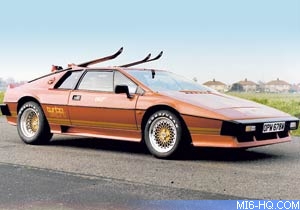How to own a James Bond car for only £11,000 with a Lotus Esprit
28-Mar-2005 • Bond News
This, you will remember, is the car used by Her Majestyâs least secret secret agent in both The Spy Who Loved Me â where it turned into a submarine â and For Your Eyes Only, in which it blew itself up before it could do anything clever at all.
The Esprit is one of the longest lived of all supercars. It was produced from 1976 until 2004 and while the later cars may have been living on after they had been eclipsed by the opposition, the earlier ones were ahead of their time.

When the Esprit Turbo was launched in 1980, Lotus found itself with a weapon that could humble the best Ferraris of the era. The Esprit was quick, of course, but like all good Lotuses the Espritâs star attraction was its handling. Drive a properly set-up Esprit today and even by modern standards its steering, grip and balance are out of the top drawer.
And for two reasons quite distinct from their looks and performance, they make fantastic classic cars. First, their bodies are glass fibre and their backbone chassis (on post-1980 models) made from galvanised steel, so they are almost rot-proof.
As body and chassis restoration is by far the most expensive component of classic car ownership, the advantage of buying an Esprit is obvious. Second, problems relating to their often shoddy original workmanship have usually been dealt with.
All the bits that were going to break and fall off should already have done so and as long as they were repaired or replaced by someone who knew what they were doing, the fact that a car may not have been that well built twenty-something years ago is increasingly irrelevant.
As you might imagine, the Esprit went through many iterations in its 28-year life, but the big dividing line in Esprit history is 1987, when the original Giugiaro-designed car was replaced by one drawn by Peter Stevens, who went on to design the McLaren F1 among others.
The Stevens cars are more spacious, easier to drive, better built and quicker than the earlier cars, but the technically inferior Giugiaro cars perhaps have more character and come with 007âs seal of approval.
All Esprits until 1996 were fitted with the same four-cylinder engine, although the power output varied from 160bhp for the first, 2 litre engine to 300bhp for the last of the Turbo models.
A 350bhp, V8 engine was used thereafter, but has suffered from reliability problems.
Buying one
Paul Matty of Paul Matty Sports Cars says the Peter Stevens Esprits are superior but acknowledges that the market is now coming round to the Giugiaro models. âItâs the James Bond effect, but if youâre going for an early car you should keep away from the very first cars, the S1 and S2. They donât have the galvanised chassis and their rear suspension is not as good.â
The best early Esprits are the Turbo and its sister, the S3. Nice S3s cost about £11,000, about £2,500 less than an equivalent Turbo, though both can be bought for a lot less â £8,000 for an average S3 and about £10,000 for a Turbo. The Turbo will take the Esprit past 150mph and is reliable if well looked after. Matty warns that the Turbo wastegate can seize if the car is left inactive for long periods. Those looking for Peter Stevens cars should pay between £14,000 for a Turbo from 1987-88 up to perhaps £23,000 for the much sought after S4 of 1994.
Mattyâs advice is clear: âThe cheapest cars in the long run are the most expensive ones to buy. Donât try to save a few pounds buying a slightly off-colour Esprit; it will cost you much more to put it right than buying the right car in the first place. It is always worth paying slightly over the odds for a car thatâs clearly been fastidiously maintained and is in fantastic condition.â
Owning one
âBuy the right car and look after it properly and thereâs no reason why a decent Esprit should not be as reliable as a Mondeo,â is the claim of Alan Morgan of the ownersâ organisation Club Lotus.
âNot only have these cars been largely rebuilt over the years,â he explains, âbut many replacement parts have been modified to cure old problems and are much better than the originals.
âThereâs no reason why a good Esprit shouldnât be more reliable as a classic car today than when it was brand new out of the factory.â
Morgan does, however, offer some words of caution. âEsprits are hand-made cars and you have to maintain them, use them, check their fluid levels and be generally sympathetic to their age and the fact that they are low-volume supercars.â
He also says they are too complex to be maintained by a competent local mechanic and need specialist attention from someone who understands their foibles.
âI would say this, but anyone considering such a car needs to join the club. We can recommend the right people to look after it and give free technical advice.â
Morgan estimates that owners need to spend £600-£800 a year as a minimum maintenance budget to keep an Esprit healthy. But he says £1,000 is a more sensible figure to build up funds for an unforeseen problem.
Vital statistics
Car Lotus Esprit Turbo (1980-7)
Engine Four-cylinder, 2174cc, DOHC
Power 210bhp @ 6500rpm
Gearbox Five-speed manual
Brakes Discs all round
Wheels and tyres (front) 7x15in with 195/60 VR15
(rear) 8x15in with 235/60 VR15
Performance 0-60mph: 5.8sec / Top speed: 153mph
Thanks to `Ken` for the alert.
 Discuss this news here...
Discuss this news here...







